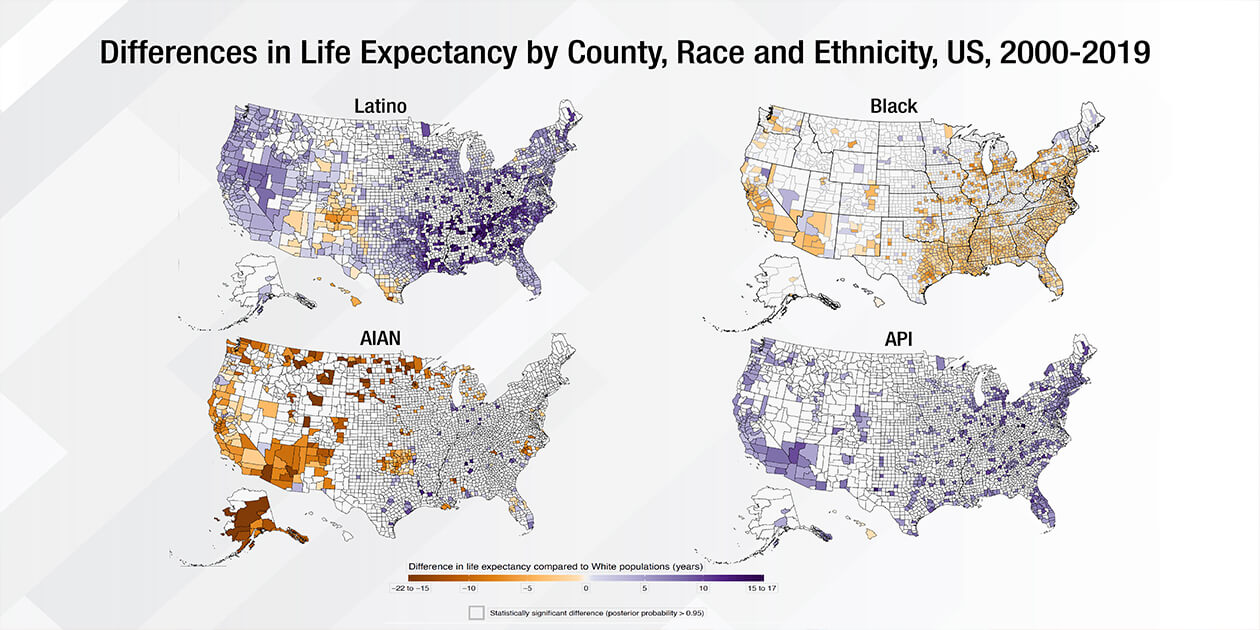Cause-specific Mortality by County, Race, and Ethnicity in the USA, 2000-2019: A Systematic Analysis of Health Disparities
An NIH-funded study published in August 2023 examined cause-specific mortality by county, race, and ethnicity in the U.S., from 2000-2019. Across 3,110 counties, researchers studied 19 causes of death among 5 racial-ethnic groups. The researchers found several patterns, including:
- Mortality is substantially higher in the American Indian and Alaska Native population and Black population than in the White population for most causes of death
- Substantial geographical variation in mortality within and across racial–ethnic groups exist for all causes of death
- Cardiovascular diseases and neoplasms were the first and second leading cause of death, respectively, within and across all racial–ethnic groups
- Diabetes and kidney diseases caused substantial mortality, landing in fifth position for leading cause of death across all racial-ethnic groups and ranking among the top five in every racial-ethnic group.
In the United States, local-level geographic data are needed to uncover and address the root causes of health disparities among different population groups.
In response to this need, NIMHD established the Global Burden of Disease U.S. Health Disparities Collaborators at NIH (a team of researchers from National Heart, Lung, and Blood Institute; National Cancer Institute; National Institute on Aging; National Institute of Arthritis and Musculoskeletal and Skin Diseases; Office of Disease Prevention; and Office of Behavioral and Social Sciences Research) and a partnership with the Institute for Health Metrics and Evaluation on a study that produced, for the first time, detailed estimates of life expectancy by race and ethnicity for every county in the United States between 2000-2019.
This collaboration supports NIMHD’s mission and points to the need to address the root causes of health disparities in order to promote healthy living and longevity for everyone.
Highlights
This ongoing NIMHD-led research collaboration has produced:
Scientific publication: Life Expectancy by County, Race, and Ethnicity in the USA, 2000-19: A Systematic Analysis of Health Disparities
This study is the first, comprehensive time-series analysis of U.S. life expectancy by race and ethnicity at the county level.
- Notably, it is the first to produce such estimates for the American Indian/Alaska Native and Asian populations.
- It is also the first U.S. county-level study that corrected for misreporting of racial and ethnic identity on death records.
This comprehensive report details U.S. county-level life expectancy estimates by race and ethnicity, further stratified by sex.
Public Platform: Data Access and Visualization Tools
An interactive website that provides the ability to download the data and data visualization tools. Researchers can use the data as a starting point for studying why the gaps in life expectancy vary so much between places or where communities do better.
Study Goals and Significance
The distribution of health outcomes, risk factors, and disparities in the United States vary by geography and population characteristics. This means that factors such as location, sex, and race and ethnicity will impact the health of people differently, conferring differential risk or protective health-related factors and resources.
For researchers and policymakers to understand the scope and complexity of health disparities and to plan effective interventions, they need comprehensive data on the population groups most impacted and the places where they live. Although such data exist, they are available mostly at the national level and for few population groups. Data on health indicators (such as life expectancy), which are used to measure health status or determine the wellbeing of a population, are limited for specific subpopulations.
This study aimed to address these data gaps by generating estimates on life expectancy by race and ethnicity at the county-level. Disaggregating data at the county level helps to uncover health disparities that are not visible using national- or state-level data; it also highlights the disparities within our local communities. Such detailed data will facilitate a more tailored and nuanced decision-making approach to reducing health disparities and improving the health of all Americans, especially those most likely to benefit.
Learn more about this study by watching the video press release:
Page updated August 11, 2023


